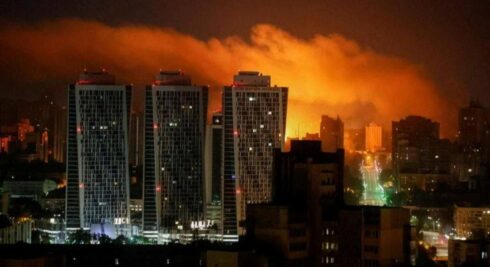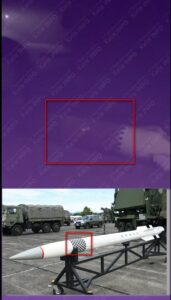In the early hours of July 10, Russian forces launched another large coordinated air assault, deploying a mix of ballistic missiles, cruise missiles, and kamikaze drones against Ukrainian military and industrial targets. According to the Air Force of Ukraine, the attack, which began in the evening of July 9 and continued past midnight, involved 415 aerial weapons, including 200 Geran-type kamikaze drones launched from multiple directions. The primary focus of the strike was Kyiv, where Russian forces aimed to cripple Ukraine’s military-industrial capacity and disrupt logistics. Ukrainian air defense failed to protect the capital, but inflicted additional damage to civilian infrastructure.
The Ukrainian Air Force reported allegedly intercepting 178 incoming targets, including 164 drones, eight Iskander-M ballistic missiles, and six Kh-101 cruise missiles. Additionally, electronic warfare systems allegedly intercepted another 204 drones and missiles. Despite these defensive efforts, the Ukrainian military was forced to acknowledge that at least eight locations suffered direct hits, with falling debris causing damage in 23 more. However, footage from across Ukraine revealed heavy damage from dozens of strikes.
The Ministry of Defense of the Russian Federation confirmed another successful attack, reporting: Last night, the Russian Armed Forces launched a group strike with high-precision long-range weapons and UAVs on enterprises of the military-industrial complex of Ukraine in Kiev and the infrastructure of the military airfield. The target of the strike has been achieved. All designated objects are affected.
Kyiv is on fire. Dozens of explosions thundered in the city and its region, including Vasilkiv, Bucha and other settlements full of military facilities.
According to preliminary reports, among the key targets struck in the city was the Artem aerospace plant in Kyiv, a facility linked to missile and drone production, which was struck multiple times. Another critical strike hit the Kuznya na Rybalskomu shipyard (formerly Lenin Forge), where Ukraine has been manufacturing naval drones and light armored vehicles. Fires also broke out near a logistics hub in the capital, identified as a BMW service station, raising suspicions that it may have been repurposed for military supply storage.
On the outskirts, Russian forces targeted the military airfield in Vasylkiv, a crucial hub for NATO-supplied arms transfers. The airfield was set on fire. Reports suggest that the strikes coincided with the arrival of new Western weapon shipments, amplifying their destructive impact.
Meanwhile, secondary explosions were reported in Chernivtsi, a western city rarely hit in previous attacks, and Lutsk in Volyn region, where strikes had also occurred the previous night. In a notable escalation, Russian forces also struck Dobropillia in the Donetsk region, a key Ukrainian logistics node for the eastern front. These are only few of the targets revealed so far.
While Ukrainian propaganda is trying to blame the Russian military for damage to civilian infrastructure, missiles of the US-made Patriot systems are falling on the heads of civilians. After almost every Russian attack, people are filming their wreckage on the streets of the densely populated areas:
The attack demonstrated Russia’s evolving tactics, including the use of Iskander-K and Iskander-M ballistic missiles. The sheer volume of incoming drones and missiles suggests that Russia is intensifying its campaign to degrade Ukraine’s defense industry. Geran drones, previously reserved for rear-area strikes, are now being deployed near the front lines, indicating increased production capacity. LINK Kyiv is afraid that Russia could soon deploy over 1,000 drones in a single wave, a concerning prospect for Ukrainian air defenses already stretched thin. LINK
As fires raged in Kyiv, Ukrainian officials scrambled to assess the full extent of the damage. The strikes underscore Moscow’s strategy of attrition, systematically dismantling Ukraine’s ability to sustain its war effort while probing for weaknesses in its air defenses. With President Zelensky absent from Kyiv during the attack—following his tradition to escape from the capital during major bombardments—the psychological toll on civilians and military alike is mounting.









zelinski is no king neither is anyone, just protected like one in a rigged game of chess where no matter how bad you are getting beat you can not lose, because they are steal stealing the peoples money and it works
zelensky is a genius, he brought down syria and mali will soon be destroyed. because of zelensky, i realized the worthlessness of russia.
i agree, he is an expert genius at playing the piano with his penis. everything else, he’s just a psychopath.
what exactly are you trying to say? either learn the language or go play with your stroke books
stroke books, is that something ghey you are expert in?
obviously inferior americunts cannot learn
bezsenné noci v kyjeve teraz čakajú banderovské fašistické beštie. aspoň raz do týždňa im teba pripraviť takéto niečo. nech si to do skončenia švo poriadne užijú. aby vedeli, že navážať sa do ruských bratov sa nevypláca. svetu mier a mysleniu zdar!!!
you are traitors alone, as is the iranian ayatollah alone. you wasted syria, and as a reward, shah reza pahlavi will take power in iran, and europe will tear russia apart for you. you may be arrogant khazarian slaves, but you forgot that they danced on the titanic before they died in the titanic. and in submarine titan the iranian billionaire enjoyed it until he turned into mortadella salami. iran has returned half a million shiites to afghanistan to be killed by the taliban. what do you think
continua a dormire
i really must have a word with your ward orderlies to up your meds and tighten your straight jacket.
the drugs obviously are not working. call shlomo for something a tad stronger before you really damage yourself.
russia not likely to fall for trump’s ceasefire that would allow ukraine more time to build a nato army to invade russia again
everyday please! no peace for nazis! dnieper should be the border between ex-soviet republic of ukraine and russia!
the russians also need to take odessa or they will never know peace in ukraine.
i don´t see a movement right now in the side of russia for even the first one… attacking odesa will make the war all the way to moldova… russia has enough weapons, and military force to start a large new offensive from bryansk, kursk and belgorod, but when you look to the maps, you see small incursions… maybe trying to overstretch maidan regime…
not at all, russia is defeated. they can just stop the war and hand over the control over russia to other nations now. vladolf needs to go to trial in haag
inferior amerikan amuses
are you scared vladolf wont be free after trial in haag? are you a chicken?
you keep running zombie nazi, you couldn’t even imitate adolf since you are complete trash. hehehe 😂
there aren´t any ukrainian civilians serving the zelenskyy regime… russian piety is the reason this war is still ragin´
instead of daily attacks… odd day attacks of 1k drones and missiles will be better… the morale of maidan regime is poor now… but ukraine is a dictatorship of thugs… so, force is needed to oust the nazis! only this will bring peace!
your morale is low as always. your shithole country yapping impress nobody. and finally your a coward not dying for vladolf in the trenches
heheheh…ukronatonazipigs getting their buttholes heavily rammed again.
the russians are hesitant to destroy the first major russian city, kiev. this has protected them until now. i’m sure the western fascists are happy about this. the collective west is the greatest threat to humanity.
zelensky is one for tradition then. a true patriot to 404, p*sses off when there’s incoming greeting cards.
what’s new. this jew has to save his precious hide. after all, they are the chosen. 🐽
if zelli-boy is habitually ‘absent’ when these events occur, then it’s only logical to presume that he’s being tipped off well in advance. can’t be that great a time lapse between detection of an assault launch and target impact.
i suppose he thinks : ‘ i didn’t sign up for this’. he’s not the perpetrator of this drawn out conflict, just some convenient figurehead.
“z” is probably using the time to practice and refine his “pole dancing” moves.
did anyone read this comment?
999,97% of missiles and drones intercepted, just see 4 missile crashing in the 2nd video!
amazing. patriots wont stop these missiles. 😬
bring it you orc shitstains!!!
russia continues with their zombie orch army ghey activities, boy fanclub is excited. hehehe 😂
impotent americunt feminine tantrums
watching the kiev nazi$ burn is almost as much fun as watching khazar occupied palestine getting disinfected by iran. can’t wait for iran to finish the job and mother russia to reduce kiev to ash. say no to filthy nazi$ and their willing idiots
maybe zelensky’s “pole” survived. how else would he and his troops be entertained.
this is useless, russia should just capitulate and vladolf travel to haag court. everybody knows this is making most sense to do. all other ideas are basically nazi and needs serious mental help on hospitals.
ramses should find competent psychiatrist
the ukrainian air force? ukraine has an air force? wtf?!😬
russian energy is essential for long term survival of ukraine…. the question is how much of it ukraine will need in the future…???
the west has wanted to loot russia’s wealth of resources for decades so ukraine is being used to deplete the russian military in preparation for something much bigger.
as all inferior americunts i am feminized insecure—as a retired macdonalds burger flipper i am envious of russians of course i am also jealous of superior angolans pygmys and eskimos—what can i do except tantrum like a bitch at sf